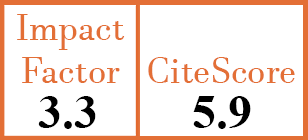Full Papers
Human epididymitis protein 4 as a biomarker of interstitial lung disease in patients with idiopathic inflammatory myopathies
E. Zanatta1, B. Moccaldi2, A. Martini3, L. Ienna4, R. Depascale5, M. Binda6, M. Gatto7, M. Zen8, M. Tonello9, A. Ghirardello10, C. Giraudo11, E. Balestro12, M. Plebani13, D. Basso14, A. Doria15, L. Iaccarino16
- Department of Medicine-DIMED, Padova University Hospital, and Department of Cardiac, Thoracic, Vascular Sciences and Public Health, Padova University Hospital, Padova, Italy.
- Department of Medicine-DIMED, Padova University Hospital, Padova, Italy.
- Department of Medicine-DIMED, Padova University Hospital, Padova, Italy.
- Department of Medicine-DIMED, Padova University Hospital, Padova, Italy.
- Department of Medicine-DIMED, Padova University Hospital, Padova, Italy.
- Department of Medicine-DIMED, Padova University Hospital, Padova, Italy.
- Department of Medicine-DIMED, Padova University Hospital, Padova, and Academic Rheumatology Centre, Department of Clinical and Biological Sciences, University of Turin, AO Mauriziano, Turin, Italy.
- Department of Medicine-DIMED, Padova University Hospital, Padova, Italy.
- Department of Medicine-DIMED, Padova University Hospital, Padova, Italy.
- Department of Medicine-DIMED, Padova University Hospital, Padova, Italy.
- Department of Cardiac, Thoracic, Vascular Sciences and Public Health, Padova University Hospital, Padova, Italy.
- Department of Cardiac, Thoracic, Vascular Sciences and Public Health, Padova University Hospital, Padova, Italy.
- Department of Medicine-DIMED, Padova University Hospital, Padova, and QI.LAB.MED, Spin-off of the University of Padova, Italy.
- Department of Medicine-DIMED, Padova University Hospital, Padova, Italy.
- Department of Medicine-DIMED, Padova University Hospital, Padova, Italy.
- Department of Medicine-DIMED, Padova University Hospital, Padova, Italy. luca.iaccarino@unipd.it
CER17913
2025 Vol.43, N°2
PI 0269, PF 0275
Full Papers
Free to view
(click on article PDF icon to read the article)
PMID: 39625826 [PubMed]
Received: 10/06/2024
Accepted : 16/09/2024
In Press: 03/12/2024
Published: 26/02/2025
Abstract
OBJECTIVES:
Human epididymis protein 4 (HE4) inhibits the degradation of type I collagen, thus promoting fibrosis. We aimed to investigate serum HE4 levels in patients with idiopathic inflammatory myopathies (IIMs), as potential biomarker of interstitial lung disease (ILD).
METHODS:
IIMs patients followed in our centre between June 2020 and January 2023 were enrolled. ILD was detected by high-resolution computed tomography (CT) and pulmonary function tests. Serum HE4 levels were measured in patients and controls. Progressive fibrosing (PF-) ILD was evaluated in patients with available 2-year follow-up (INBUILD criteria).
RESILTS: We enrolled 90 consecutive IIMs patients (68% females, mean age 59.5 [52.75- 66.0] years) and 42 healthy, age- and sexmatched controls. ILD was diagnosed in 44 (49%) patients. Serum HE4 levels were higher in IIMs patients than controls: 78.55 [54.6-114.4] vs. 51.05 [41.8-62.8] pmol/L (p=0.001). IIMs-ILD patients had higher levels of HE4 vs. those without ILD (193.7 [78.92-137.42] vs. 58.15 [48.32-79] pmol/L, p<0.0001). Serum HE4 levels correlated inversely with diffusing capacity for carbon monoxide (rho=-0.556, p<0.0001) and total lung capacity (rho=-0.459, p=0.001). Serum HE4 levels were the only variable independently associated with IIMs-ILD in two models of multivariate analysis: OR 1.063 (CI 95% 1.02-1.108), p=0.004, and OR 1.059 (CI 95% 1.020-1.099), p=0.003. PF-ILD was detected in 39.4% of IIMs-ILD patients with available follow-up (33/44), without any significant association with baseline serum HE4 levels.
CONCLUSIONS:
HE4 might be a useful biomarker in the identification and assessment of ILD in IIMs patients.


